Amaro Pargo facts for kids
Quick facts for kids
Amaro Pargo
|
|
|---|---|
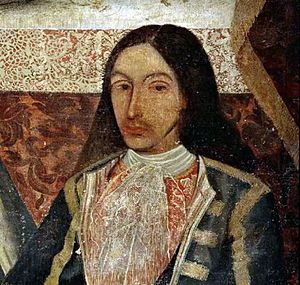 |
|
| Born |
Amaro Rodríguez-Felipe y Tejera Machado
3 May 1678 |
| Died | 4 October 1747 (aged 69) San Cristóbal de La Laguna, Tenerife, Crown of Castile
|
| Piratical career | |
| Nickname | Amaro Pargo |
| Years active | 1712–1729 |
| Rank | Captain |
| Base of operations | Atlantic West Indies |
| Commands | El Bravo, Ave María, El Clavel, Fortuna, etc |
| Signature | |
 |
|
Amaro Rodríguez-Felipe y Tejera Machado (born May 3, 1678 – died October 4, 1747), known as Amaro Pargo, was a famous Spanish corsair. A corsair was like a private ship captain who was allowed by their government to attack enemy ships during wartime. He was one of the most well-known corsairs in Spain during the time often called the Golden Age of Piracy.
Amaro Pargo was known for his business activities. He also gave a lot of money to churches and helped people who were poor. As a corsair, he sailed often between Cádiz in Spain and the Caribbean. He attacked ships belonging to countries that were enemies of Spain, mainly England and Holland. Because of his actions, people at the time saw him as a hero. Some even called him "the Spanish version of Francis Drake". In 1725, he was given the title of a Caballero hidalgo, which meant he was recognized as a nobleman.
Contents
Why Was He Called Amaro Pargo?
For many years, people wondered why Amaro Rodríguez Felipe was nicknamed Pargo. The word "Pargo" is also the name of a type of fish, the red porgy.
Some believed the nickname meant he was "fast" and "hard to catch" in battles at sea. They thought he moved like the fish. More recently, some theories suggest the nickname came from his facial features.
However, newer ideas from experts like Professor Manuel de Paz and researcher Daniel García Pulido suggest the nickname was not about his face. Instead, they think it was the nickname of his family's group or clan.
Amaro Pargo's Life Story
His Early Years
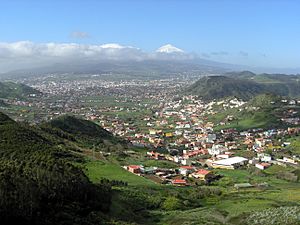
Amaro Rodríguez Felipe was born on May 3, 1678. His hometown was San Cristóbal de La Laguna, on the island of Tenerife in the Canary Islands.
He was baptized in the Church of Our Lady of Los Remedios, which is now a cathedral. His parents were Juan Rodríguez Felipe and Beatriz Tejera Machado. Amaro had seven brothers and sisters. Three of his sisters became nuns in a local convent. His family was wealthy and owned land and homes in and around the city.
Amaro lived with his family in the Plaza de San Cristóbal in La Laguna. His family owned several properties, many of them near the city's main areas.
In 1701, Amaro started his sea career as a second lieutenant on a ship called Ave María, also known as La Chata. This ship was attacked by pirates. Amaro told the captain to pretend to give up. This trick allowed them to start a surprise fight, which they won. The grateful captain then gave Amaro his first ship. With this ship, Amaro began his own trading business. He also became involved in the trade of enslaved people in Latin America. For these activities, King Philip V of Spain gave Amaro Pargo a special permission called a letter of marque.
A Trader and Corsair
Amaro Pargo likely started working with the West Indies Fleet between 1703 and 1705. During this time, he was known as a "captain" and "master" of a ship called Ave María y Las Ánimas. He sailed between the port of Santa Cruz de Tenerife and Havana, Cuba. He also owned other ships, including Nuestra Señora de Los Remedios, Santo Domingo, and Santa Águeda (nicknamed El Gavilán). Later, in 1737, he owned El Mercader de Canarias and shared ownership of another trading ship.
Amaro Pargo managed his businesses with a strong fleet of ships and many properties. He sailed his own ships to America. He carried goods like wine from his own farms and brandy. He sold these in Havana and Guyana. On his return trips, he attacked ships belonging to Spain's enemies, mainly British and Dutch vessels. He took their goods, which he then brought back to Spain. Amaro Pargo even fought against famous pirates of his time, including Blackbeard. He also traded other products like textiles and nuts, bringing them from the Canary Islands to the Indies.
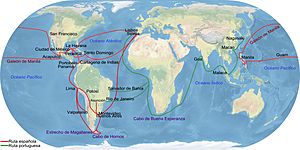
In 1712, Amaro Pargo captured an English ship called the Saint Joseph. This ship was from Dublin in Ireland and was led by Captain Alexander Westher. Amaro Pargo was accused of being too harsh in how he took the ship. He had taken its goods and forced Captain Westher to sail with his ship to the port of Santa Cruz de Tenerife. If Westher refused, Amaro Pargo threatened to sink the English ship. However, capturing this English ship was seen as fair because England was an enemy of Spain.
King Felipe V gave Amaro Pargo permission in 1719 to build a ship in Campeche. This ship was a merchant vessel armed with 58 guns. It was very large. This ship joined the Spanish Navy in 1723. A year before that, it had captured and looted a Dutch ship called the Duyvelant. It is believed Amaro Rodríguez Felipe was the captain at that time.
Sometimes, taking goods from enemy ships led to battles. It is recorded that Amaro Pargo once boarded a large ship from Jamaica. This led to a fight between Amaro Pargo and the ship's captain, using swords and pistols. The captain was badly hurt, and Amaro Pargo only got a cut on his fingers. He also fought against Turkish pirates near the Canary Islands.
Amaro Pargo had a romantic relationship with Josefa María del Valdespino from Cuba. They had a son named Manuel de la Trinidad Rodríguez, but they did not marry. He also had another son, Juan Rodríguez Felipe, born in Santa Cruz de Tenerife. Juan's mother was a married woman who knew Amaro's family. Amaro Pargo's mother, Mrs. Beatriz Tejera, raised Juan.
Amaro Pargo created a special fund to help people in need. He gave money to the poor in prisons. Over time, Amaro Pargo became the richest man in the Canary Islands. He was as famous and well-known in his time as Blackbeard and Francis Drake.
Becoming a Nobleman
On January 25, 1725, Amaro Pargo was officially recognized as a Caballero hijodalgo. This meant he was part of the lower nobility. He also received official papers proving his noble status and royal coat of arms on January 9, 1727, from the King of Arms for Felipe V of Spain.
Friendship with Sister Mary of Jesus
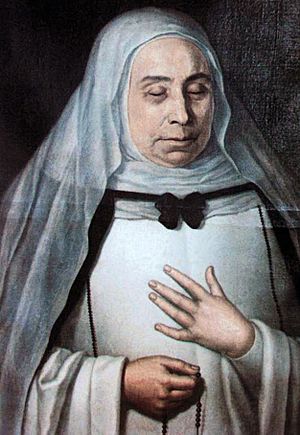
Amaro Pargo was a very religious Catholic. He gave a lot of money to churches and religious groups. He especially helped the Parish Church of Our Lady of Los Remedios, which is now the La Laguna Cathedral. He became very good friends with a nun named Sister Mary of Jesus. She gave him spiritual advice. When she died in 1731, Amaro paid for the special coffin where her body, which was said to be uncorrupted, now rests. Amaro's initials are carved into the coffin.
Amaro Pargo believed that many of his successes were due to the nun's help. He even said she saved his life in Cuba once, even though her body never left the convent. This was believed to be a miracle called bilocation, where a person appears in two places at once.
Over the years, some people have wondered if the friendship between the corsair and the nun was more than just spiritual. Some authors have suggested a deeper romantic meaning. However, others believe their friendship was purely based on their shared religious beliefs.
His Death and What He Left Behind
Amaro Pargo died on October 4, 1747, in his hometown. Records say his funeral was "very grand." During the procession to his burial place, the crowd was so large that the procession stopped eight times in the street.
He was buried in a family tomb in the Santo Domingo de Guzmán Convent in La Laguna.
On his marble tombstone, you can see his family's shield. Below it, there is a skull winking its right eye, with two crossbones. When he died, he left behind a very large fortune. His natural son, Manuel de la Trinidad Rodríguez, came to La Laguna to claim his share, but the other heirs did not accept his claims.
Amaro Pargo's Hidden Treasure
In his will, Amaro Pargo wrote that he had a special box in his cabin. This carved chest held silver, gold jewelry, pearls, and valuable precious stones. It also contained chinese porcelain, expensive fabrics, and paintings. He added that all these items were listed in a book wrapped in parchment and marked with the letter "D". No one knows where this book is today.
For centuries, people have wondered where Amaro Pargo's treasure is hidden. His house in Machado (in the area of El Rosario) has been searched many times by treasure hunters. Some also think the treasure might be in the Cave of San Mateo in Punta del Hidalgo, in the northeast of Tenerife. This cave was supposedly used to hide his loot.
Despite all these searches, this treasure has never been found.
Looking at His Remains
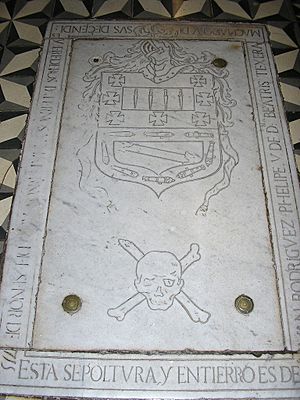
In November 2013, a team of archaeologists and scientists from the Autonomous University of Madrid dug up Amaro Pargo's remains. They wanted to study him, including doing DNA tests and trying to recreate what his face looked like.
Old records said that Amaro Pargo was buried with his parents and a black servant. However, the scientists found six more people buried there, along with some incomplete remains of babies. It is thought that some of these people were Amaro Pargo's nephews or great-nephews. The babies, however, were not related to him. It is believed that burying unbaptized children next to an adult was a custom in Spain and the Canary Islands. People thought the adult would guide the babies to Heaven.
A French video game company called Ubisoft paid for the exhumation. They did this to promote their video game Assassin's Creed IV: Black Flag and also Naughty Dog's game Uncharted. A supervisor from the company said that Amaro Pargo was "a character who in his time had the same reputation and popularity as Blackbeard or Francis Drake".
See Also
 In Spanish: Amaro Pargo para niños
In Spanish: Amaro Pargo para niños
- Cabeza de Perro
- Miguel Enríquez (privateer)

